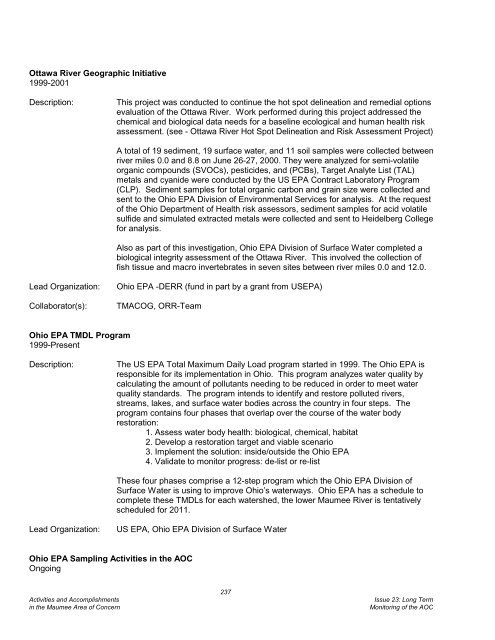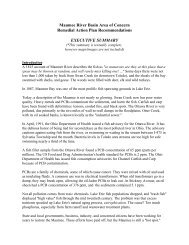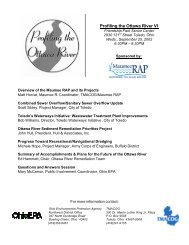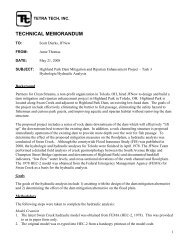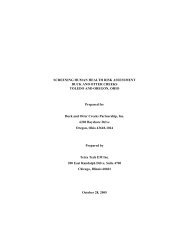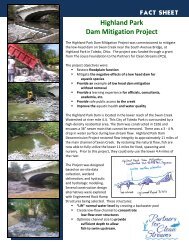Complete report - Partners for Clean Streams
Complete report - Partners for Clean Streams
Complete report - Partners for Clean Streams
You also want an ePaper? Increase the reach of your titles
YUMPU automatically turns print PDFs into web optimized ePapers that Google loves.
Ottawa River Geographic Initiative<br />
1999-2001<br />
Description:<br />
This project was conducted to continue the hot spot delineation and remedial options<br />
evaluation of the Ottawa River. Work per<strong>for</strong>med during this project addressed the<br />
chemical and biological data needs <strong>for</strong> a baseline ecological and human health risk<br />
assessment. (see - Ottawa River Hot Spot Delineation and Risk Assessment Project)<br />
A total of 19 sediment, 19 surface water, and 11 soil samples were collected between<br />
river miles 0.0 and 8.8 on June 26-27, 2000. They were analyzed <strong>for</strong> semi-volatile<br />
organic compounds (SVOCs), pesticides, and (PCBs), Target Analyte List (TAL)<br />
metals and cyanide were conducted by the US EPA Contract Laboratory Program<br />
(CLP). Sediment samples <strong>for</strong> total organic carbon and grain size were collected and<br />
sent to the Ohio EPA Division of Environmental Services <strong>for</strong> analysis. At the request<br />
of the Ohio Department of Health risk assessors, sediment samples <strong>for</strong> acid volatile<br />
sulfide and simulated extracted metals were collected and sent to Heidelberg College<br />
<strong>for</strong> analysis.<br />
Also as part of this investigation, Ohio EPA Division of Surface Water completed a<br />
biological integrity assessment of the Ottawa River. This involved the collection of<br />
fish tissue and macro invertebrates in seven sites between river miles 0.0 and 12.0.<br />
Lead Organization:<br />
Collaborator(s):<br />
Ohio EPA -DERR (fund in part by a grant from USEPA)<br />
TMACOG, ORR-Team<br />
Ohio EPA TMDL Program<br />
1999-Present<br />
Description:<br />
The US EPA Total Maximum Daily Load program started in 1999. The Ohio EPA is<br />
responsible <strong>for</strong> its implementation in Ohio. This program analyzes water quality by<br />
calculating the amount of pollutants needing to be reduced in order to meet water<br />
quality standards. The program intends to identify and restore polluted rivers,<br />
streams, lakes, and surface water bodies across the country in four steps. The<br />
program contains four phases that overlap over the course of the water body<br />
restoration:<br />
1. Assess water body health: biological, chemical, habitat<br />
2. Develop a restoration target and viable scenario<br />
3. Implement the solution: inside/outside the Ohio EPA<br />
4. Validate to monitor progress: de-list or re-list<br />
These four phases comprise a 12-step program which the Ohio EPA Division of<br />
Surface Water is using to improve Ohio’s waterways. Ohio EPA has a schedule to<br />
complete these TMDLs <strong>for</strong> each watershed, the lower Maumee River is tentatively<br />
scheduled <strong>for</strong> 2011.<br />
Lead Organization:<br />
US EPA, Ohio EPA Division of Surface Water<br />
Ohio EPA Sampling Activities in the AOC<br />
Ongoing<br />
Activities and Accomplishments<br />
in the Maumee Area of Concern<br />
237<br />
Issue 23: Long Term<br />
Monitoring of the AOC


